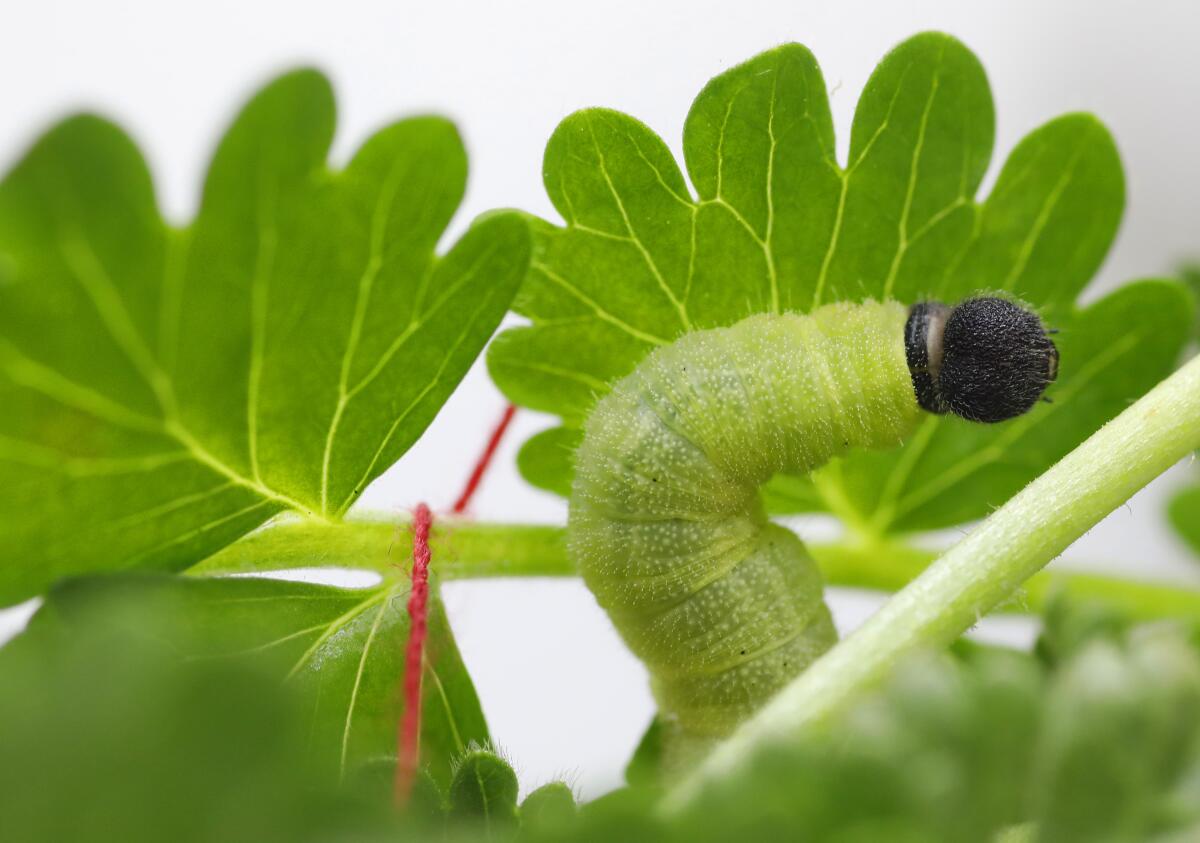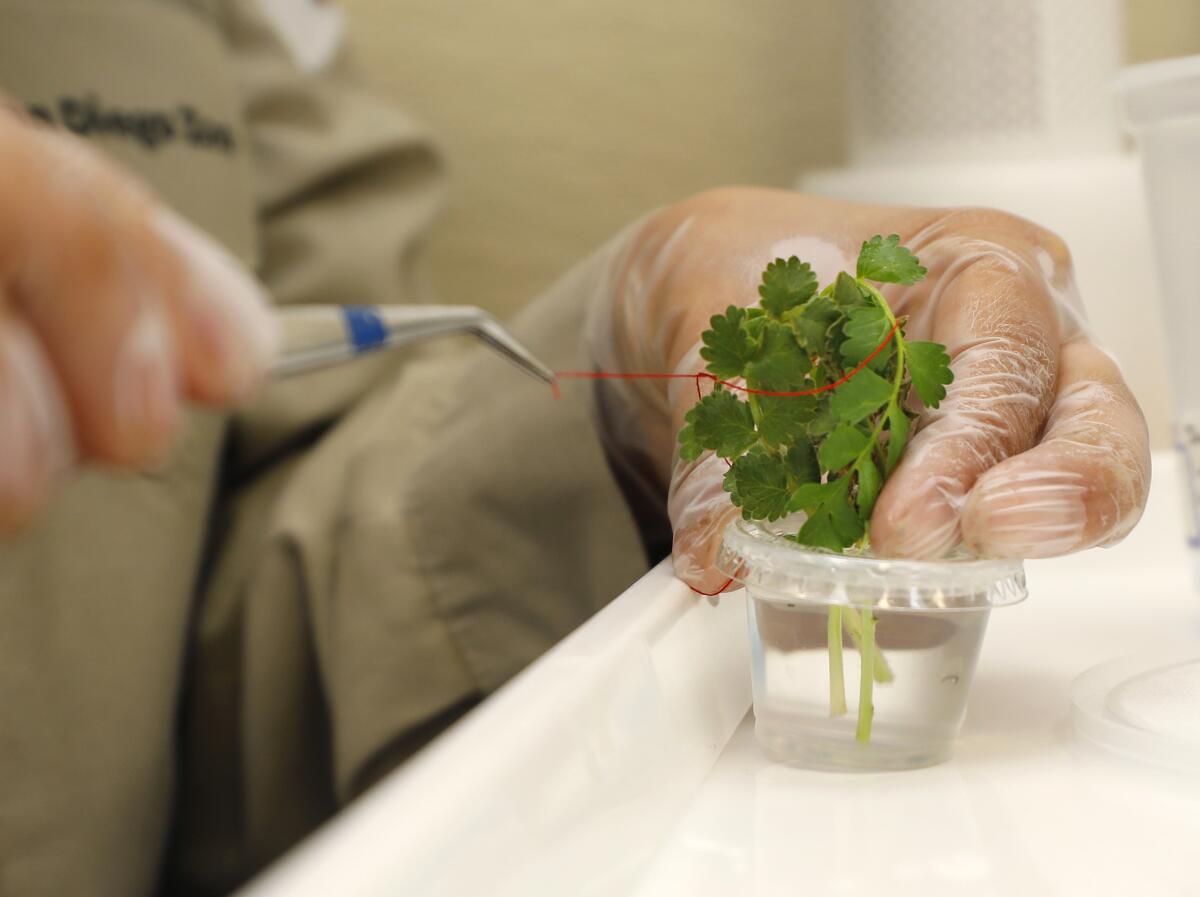The San Diego Zoo is racing to save these rare butterflies before they vanish
- Share via
SAN DIEGO — High up in the mountains of San Diego County, some of San Diego’s rarest butterflies flutter from flower to flower in meadows with creeks and streams.
But life isn’t as idyllic for the Laguna Mountains skipper as it may sound. These endangered butterflies have vanished from the very mountain range they were named for and are now found only on Palomar Mountain. Climate change, human activity and wildfires threaten to wipe them out altogether.
Ecologists and wildlife experts are trying to change that, with a coalition that includes the San Diego Zoo, the U.S. Fish and Wildlife Service and the U.S. Forest Service, among others. Their goal is to return the skippers to their former habitat in the Laguna Mountains and ensure they thrive.
That will take time and money. According to a U.S. Fish and Wildlife Service report, it could cost more than $3 million and take until 2045 for the species to recover to the point where it is no longer considered endangered.
It might seem like a lot of effort for a butterfly someone may never have seen or heard of, acknowledges Daniel Marschalek, an insect ecologist who studied the skippers from 2013 to 2017 while at San Diego State University. But he says the measures conservationists take to save these butterflies will help other plants and animals in their ecosystem, too.
“Once you start noticing species that start to decline and maybe disappear altogether in certain areas, it should really be kind of a warning sign,” said Marschalek, an assistant professor at the University of Central Missouri. “It’s reasonably easy to document a decline. But then to figure out why — because it’s usually multiple factors — and then change them, that’s kind of the difficult part.”
Hanging on by a silk thread

The Laguna Mountains skipper is a tiny critter, with a 1-inch wingspan and black wings mottled with white spots.
This butterfly subspecies was last seen in the Laguna Mountains in 1999, and no one quite knows why it vanished. Global warming and a steady dip in rainfall across the region certainly haven’t helped, as these butterflies favor wet mountain meadows. A 2019 report by the U.S. Fish and Wildlife Service cites habitat destruction from cattle grazing as another factor.
The only Laguna Mountains skippers left live in four locations on Palomar Mountain — and nowhere else on Earth. Researchers don’t know how many of these butterflies are left, but Marschalek says their situation doesn’t bode well for their survival.
“Especially in Southern California, if you have one kind of area that a species is restricted to, eventually it’s going to burn,” he said. “It’s just a matter of time.”
Skippers aren’t capable of the long flights that have made monarch butterflies famous. That means the population on Palomar Mountain can’t travel to the Laguna Mountains — or anywhere else, for that matter.
At least not without help.
“They’re not there. And they can’t get there from Palomar on their own. So we’re going to take them,” said Paige Howorth, the San Diego Zoo’s curator of invertebrates. “We feel like the habitat is ready.”
A helping hand

A series of conservation measures going back to the 1980s has helped preserve the skipper’s habitat in the Laguna Mountains by limiting cattle grazing and visitor access. That work is now entering a new phase, with the zoo hatching skipper eggs and rearing caterpillars in its lab; the caterpillars will be taken to the mountains.
It’s painstaking work, says Howorth and her team. They’ve received more than 400 eggs, which they’ve hatched into more than 300 caterpillars.
Every morning, zoo staff give the caterpillars a spritz of water to simulate the dew that the larvae would drink in the wild. Then the caterpillars get back to quietly munching on their favorite food source: Cleveland’s Horkelia, a small herb native to Southern California and Baja California.
As they eat, they eject small black specks of frass, entomologist-speak for poop. Howorth’s team sifts through these poop pellets for something that looks almost identical to frass but certainly isn’t: the caterpillar’s last head capsule, the tough outer layer that protects its head and which is shed while growing. The size of this capsule tells researchers what stage of development the larvae have reached.

Once the increasingly plump caterpillars stop eating and form a chrysalis, they’ll be taken to the Laguna Mountains for release. Most of the chrysalises will stay dormant until next spring, when the butterflies will finally emerge.
But the work doesn’t stop there. The zoo and its conservation partners will continue to monitor the new population for years to come. And they’ll keep running captive rearing programs in their labs each spring. Those reintroductions could take 10 years and cost $700,000, according to the 2019 U.S. Fish and Wildlife Service’s report.
San Diego Zoo Wildlife’s latest financial audit shows that it spent about $24 million on research and conservation in 2020. While many of these projects are in far-flung parts of the globe, Howorth says it’s nice to let San Diegans know there’s work going on right here, including efforts to protect the Quino checkerspot and Hermes copper butterflies, both local species that are also threatened.
“It’s meaningful to do something in San Diego for San Diego butterflies,” she said.
Wosen writes for the San Diego Union-Tribune.
More to Read
Sign up for Essential California
The most important California stories and recommendations in your inbox every morning.
You may occasionally receive promotional content from the Los Angeles Times.














